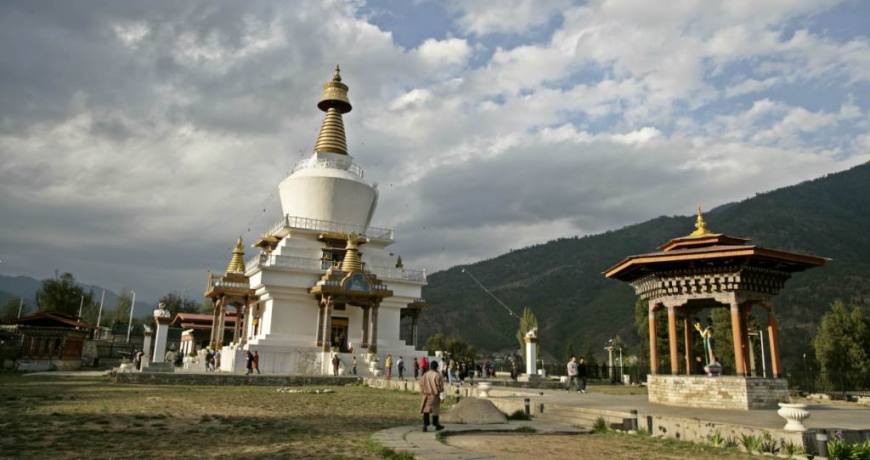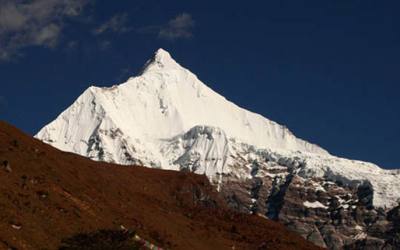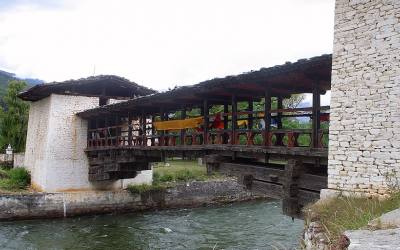Visitors to Bhutan are few enough, but those who have the chance to venture right across the kingdom to its little known eastern region are privileges indeed. The tour commences in Paro, that most picturesque valley in western Bhutan where time is spent visiting the famed Paro Dzong and the Tiger’s Nest Monastery perched high on cliffs above the upper reaches of the valley. From here you head north to Thimphu, the tiny capital of Bhutan and then on along the one road which heads east. You will pass the great dzongs of Wangdiphodrang and Tongsa built on steep cliffs above the villages. The deeply forested terrain begins to widen out into broad, beautiful valleys as you head into Bumthang in central Bhutan and on to Mongar, crossing you highest pass, the Thumshing La (3800m).
Continuing further east the scenery begins to change from conifer and deciduous forests to semitropical vegetation as the altitude drops to around 1800 meters. Finally you reach Tashigang, Bhutan’s second largest town. The fantastic Tashigang Dzong, which was built in 1680-94, towers over this lush valley. This fort has proved impregnable, being surrounded by a river and ravines on three sides and a high mountain to the north. The people of this region are renowned for their exquisite textile and handicrafts. After a couple of days here exploring the town and soaking up the atmosphere you drive on to Gauhati (Assam) for the return flight. This remarkable tour gives you the chance to see a cross section of Bhutan, with its rich cultures and varied scenery.
Day 01: Arrival and transfer to hotel in kathmandu
Day 02: Sight seeing around kathmandu valley with English speaking guide
Day 03: Fly to paro
Day 04:Paro, Excursion to Taktsang Monastery
Day 05: Thimphu Sightseeing:
Day06:Thimphu Sightseeing:
Day 07. Punakha – Gangtey – Trongsa:
Day 08. Trongsa - Bumthang:
Day 09. Bumthang Sightseeing:
Day 10. Bumthang – Wangdi Phodrang
Day 11. Wangdiphodrang – Thimphu:
Day12 : Drive to Paro airport for the connecting flight to Kathmandu
Day13: Sight seeing tour to Bhaktapur city and Changu Narayan temple
Day14: Tour Ends ( Departure onwards)
Day01: Arrival and transfer to Hotel in Kathmandu
Upon arrival in Kathmandu. Our airport representative will be waiting outside the airport terminal a few metres from the exit door. Please check your name at play card. He will bring you to hotel in kathmandu. The drive from the airport to the hotel is around 20 minutes.
Day02: Free day in Kathmandu or sight seeing around kathmandu valley with English speaking guide.
Hanumandhoka ( Kathamdnu Durbar Square ):
It is the historic seat of royalty. The Durbar Square , with its old temples and palaces, epitomizes the religious and cultural life of people. It is here that kings of Nepal are crowned and their coronations solemnized. Interesting things to see here are, Taleju temple built by king Mahendra Malla in 1954 AD, the temple of Kal Bhairab , the god of destruction, Nautale durbar, the statue of King Pratap Malla, the big drum and the Jaganath temple. It was listed in the UNESCO world heritage monument list in 1979.
On the right hand corner, a large wooden lattice screen hides an enormous gilded face of Sweta Bhairab. The screen is removed only during the Indra Jatra festival.. there are also the Numismatic museum and Tribhuban museum inside the Hanuman Dhoka palace building . Photography is prohibited inside the museums. Both the mseums remain closed on Tuesday and government holidays.
Swoyambhunath ( Monkey temple)
This is one of the world’s most glorious Buddhist Chaityas. It is said to be 2,000 years old. Painted on the four sides of the spire’s base are the all seeing eyes of Lord Budhha. It is 3Km west of Kathmandu city and it situated on a hillock about 77 m commands an excellent view of the Valley. This stupa is the oldest of its kind in Nepal . It was listed in the UNSCO world Heritage Monument List in 1979.
Boudhanath stupa
Boudhanath Stupa (or Bodnath Stupa) is the largest stupa in Nepal and the
holiest Tibetan Buddhist temple outside Tibet . It is the center of Tibetan
culture in Kathmandu and rich in Buddhist symbolism. The stupa is located in
the town of Boudha , on the eastern outskirts of Kathmandu .
History
Bodnath was probably built in the 14th century after the Mughal invasions;
various interesting legends are told regarding the reasons for its construction. After the arrival of thousands of Tibetans following the 1959 Chinese invasion, the temple has become one of the most important centers of Tibetan Buddhism. Today it remains an important place of pilgrimage and meditation for Tibetan Buddhists and local Nepalis, as well as a popular tourist site.
Pashupatinath Temple :
Situated 5km east of kathamandu, the temple of Lord Shiva , Pashupatinath, with two tired golden roof and silver door is considered one of the holiest for Hindus. Although only Hindus are allowed inside the temple, visitors can clearly see the temple and the activites performed in the Temple premises from the eastern bank of the Bagmati river. The Temple was listed in the UNESCO world heritage Monument List in 1979
Day 03. Arrive Paro (By Druk Air flight): Your Guide from local Travel agency will receive you at the airport and drive you the short distance to the hotel. After Tea, drive to the ruins of the Drukgyal Dzong 16 km up the valley built in 1647 by the great Shabdrung Ngawang Namgyal, father and unifier of medieval Bhutan, the dzong was destroyed by accidental fire and left in ruins as an evocative reminder of the great victories it was built to commemorate. Explore the ramparts and on a clear day experience an unforgettable view of Mt. Jhomolhari (7,314 m). On the way back, visit Kichu Lhakhang, built in 659 A.D by the Tibetan king Srongsen Gampo. Dinner and over night in Hotel.
Day 04. Paro, Excursion to Taktsang Monastery: A very special day, with an excursion to view the spectacular Taktsang (Tiger’s Nest) monastery - After breakfast a short drivetakes us to Satsam Chorten, from there a 2 hour walk till the view point of the monastery. The trail climbs through beautiful pine forest, many of the trees festooned with Spanish moss, and an occasional grove of fluttering prayer flags. We stop for a rest and light refreshments at the Taktsang Jakhang (cafeteria) and then walk a short distance until we see, clearly and seemingly within reach, Taktsang monastery. The primary Lhakhang was built around Guru Rimpoche’s meditation cave in the 1684by the Penlop of Paro Gyaltse Tenzin Rabgay, this incredible monastery clings to the edge of a sheer rock cliff that plunges 900 meters into the valley below. Legend has it that Guru Padmasambhava, the tantric mystic who brought Buddhism to Bhutan, flew here on the back of a flying tiger, Dorji Drolo, said to be his favourite consort.
After Lunch, visit Ta Dzong (built in1656 and renovated in 1968), an ancient watchtower, which now houses the National Museum. Below the museum is the Paro Rimpung Dzong (literally meaning “Heap of Jewels”, built in 1646 by Shabdrung Ngawang Namgyal, the centre of civil and religious authority in this valley. A short walk takes you to the base of the dzong and across a traditional cantilevered, covered bridge. In the evening, drive to Thimphu. Dinner and over night in Hotel.
Day 05. Thimphu Sightseeing: The day begins with a visit to the National Memorial Chorten (1974) built in honor of our late King Jigme Dorji Wangchuk and the Dupthop Lhakhang one of the few surviving nunneries in Bhutan. We then visit the National Library, stocked with ancient Buddhist manuscripts, and the PaintingSchool where traditional art is still kept alive through instructions in the art of painting Thangkas (sacred Buddhist religious scrolls). After lunch we drive to the Traditional Medicine Institute where medicines are prepared according to ancient practices. Other highlights include a visit to the Tashichho Dzong, seat of the national government and the Central Monastic Body, including the summer residence of the Je Khenpo (Chief Abbot of Bhutan). Finally visit the Handicrafts Emporium followed by shopping for souvenirs in the shops of Thimphu. Over night in Hotel.
Day 06. Thimphu - Punakha: (72 Kms, 3 hours drive). After breakfast, Drive to Punakha via Dochula pass. If the weather is clear, we stop for a while at Dochula pass to view Higher Himalayas. On the way, visit Chime Lhakhang, which was built by Lama Drukpa Kuenley. He subdued the demons with his “Magical Thunder bolt”. The Temple is also known as “the Temple of Fertility”. Lunch at Punakha.
After lunch, visit Punakha Dzong built in 1637 by Shabdrung Ngawang Namgyal and is situated between Pho Chu (Male River) and Mo Chu (Female River). For many years until the time of the second king, it served as the seat of the Government. The construction of the Dzong was foretold by Guru Rimpoche, who predicted, “…a person named Namgyal will arrive at a hill that looks like an elephant”. There was a smaller building here called Dzong Chu (Small Dzong) that housed a statue of Buddha. It is said that Shabdrung ordered the architect, Zowe Palep, to sleep in front of the statue, while Palep was sleeping; the Shabdrung took him in his dreams to Zangtopelri and showed him the palace of Guru Rimpoche. From his vision, the architect conceived the design for the new Dzong, which in keeping with the tradition, was never committed to paper. The Dzong was named Druk Pungthang Dechen Phodrang (Palace of Great Happiness). The war materials captured during the battle with Tibetans are preserved here. Punakha is still the winter residence of Je-Khenpo and King Jigme Dorji Wangchuk convened the new national Assembly here in 1952.Overnight in Hotel.
Day 07. Punakha – Gangtey – Trongsa: We start early today. After breakfast drive to Trongsa via. Gangtey. Enroute sightseeing in the valley of Wangdiphodrang, it includes: visit to Wangdiphodrang Dzong (from outside) built in 1638. Legend relates that as the people were searching for the site of the Dzong; four ravens were seen flying away in four directions. This was considered auspicious sign, representing the spread of Buddhist religion to the four points of the compass. The Dzong is situated at the confluence of Mo Chu and Tang Chu rivers. Drive further to Gangtey. While in Gangtey, visit Gangtey Gompa. Gyaltse Pema Thinley, the grandson and mind reincarnation of Pema Lingpa founded the Temple in 1613, and Tenzin Legpai Dhendup, the second re-incarnation, built the temple. The present Abbot, Kunzang Pema Namgyal is the ninth re-incarnation. It is a Nyingmapa monastery and is affiliated to other Nyingmapa monasteries including Tamshing in Bumthang. Explore Phobjikha valley, famous for the Black Necked Cranes during winter. Packed lunch will be served at Gangtey. After Lunch, drive to Trongsa. Visit Trongsa Dzong, the most impressive dzong in Bhutan, built in its present form in 1644 by Chogyal Minjur Tempa, the official who was sent by Shabdrung to unify eastern Bhutan and enlarged at the end of the 17th century by Desi Tenzin Rabgay. Trongsa Dzong is the ancestral home of the present Royal Family and first two hereditary kings ruled Bhutan from this Dzong. Then Visit Ta Dzong, an ancient watch tower. The chapel inside the Ta Dzong is said to be dedicated to the Trongsa Penlop Jigme Namgyal. Over night in Hotel.
Day 08. Trongsa - Bumthang: After breakfast, drive to Bumthang. Lunch at Bumthang. After lunch, visit Jakar Dzong, which literally means “The Castle of White Bird”. The current structure was built in 1667 and is said to be the largest Dzong in Bhutan and then visit Lamey Goemba, a large palace and monastery built in 18th century by Dasho Phuntsho Wangdi. Visit Jambay Lhakhang said to have been built by King Srongsen Gampo of Tibet in the year 659 on the same day as Kichu Lhakhang in Paro. The temple was visited by Guru Rimpoche during his visit to Bumthang and was renovated by Sindhu Raja after Guru Rimpoche restored his life force. Under the temple is said to be a lake in which Guru Rimpoche hid several Terma. In October one of the most spectacular festival, “Jambay Lhakhang Drup” is staged here. Over night in Hotel.
Day 09. Bumthang Sightseeing: After breakfast, visit Kurjey Lhakhang that is named after body print of Guru Rimpoche, built in 1652 by Minjur Tempa. Visit Tamshing Lhakhang (Temple of the good message), established in 1501 by Pema Lingpa and is the most important Nyingmapa temple in the kingdom. After lunch, visit Membartsho (Literally means “Burning Lake”), a short distance up the road leading to Tang valley. The Terton Pema Lingpa discovered several of Guru Rimpoche’s hidden Terma / relics here. In the evening, visit Mathra factory & Cheese Factory. Over night in Hotel.
Day 10. Bumthang – Wangdi Phodrang: Early breakfast, drive to Wangdiphodrang. Packed lunch will be served on the way. Over night in Hotel.
Day 11. Wangdiphodrang – Thimphu: After breakfast, drive to Thimphu. After lunch, Excursion to Tango Monastery. Dinner and over night in Hotel.
Day12 : Drive to Paro airport for the connecting flight to Kathmandu. During the afternoon sight seeing around Patan.
Patan
The ancient city of Patan , lying 5 km southwest of kathmandu, is known as the city of fine arts, The city is full of Hindu temples and Buddhist
monuments. The diversity of the medieval culture that allowed both Hinduism and Buddhism to flourish has left a rich legacy of impressive sightseeing in this city for today’s visitors.
Patan Durbar Square:
Situated in the heart of the city, constitutes the focus of visitor’s
attraction. The square is full of ancient palaces, Temple and shrines, noted for their exquisite carvings. The Patan durbar Square consist of three main chowks or countryards, the Central Mul Chowk, Sundari Chowk and Keshar narayan Chowk, The Sundari Chowk holds in its center a masterpiece of stone architecture. The Royal Bath called Tushahity. It was listed in the UNESCO world HeritageMonument list in 1979.
Krishna Mandir:
Built in 1637 AD, the temple of Lord Krishaa holds a commanding position in the palace complex of Patan. It is supposed to be the first specimen of Shikhara style architecture in Nepal . It is the only temple in Nepal having 21 spires and is completely 21 spires and is completely mad of stone.
Day13: Sight seeing tour to Bhaktapur city and Changu Narayan temple
Bhaktapur durbar Squares:
The Golden Gate is the entrance to the main courtyard of the Palace of 55 Windows.Built by King Ranjit Malla. The gate is one of the most beautiful and richly carved specimens of its kind in the entire world. This gate is embellished with deities and monsters with marvelous intricacy. The palace of 55 windows was built in 1700 AD. Among the brick walls in their gracious setting and sculptural design, is a balcony of 55 windows. This balcony is a masterpiece of wood carving. The stone temple of Batsala Devi which is also located in the Durbar Square is full of intricate carvings. This temple also sets a beautiful example of Shikhara style architecture in Nepal. There is a bronze bell on the terrace of the temple which is also known as the Bell of Barking Dogs.
This colossal bell, placed in 1737 AD, was rung to signal curfew those days.
The main square of the city contains innumerable temples and other architectural showpieces like the Lion Gate, the statue of King Bhupatindra Malla, the Picture Galley, the Batsal Temple, etc. A magnificent statue of King Bhupatindra Malla in the act of worship is placed on the column facing the palace. It was listed in the UNESCO World Heritage Monument list in 1979.
Changu Narayan:
Situated at the end of a long ridge which runs well into the Valley, It is said to have been built by king Hari Dutta in 323 AD said to be the oldest temple in the valley. It was listed in the UNESCO world Heritage Mountain list in 1979
Day14: Tour Ends ( Departure onwards)
What’s Included
- All Meals [Breakfast /Lunch/Dinner]
- Accommodation [Twin Sharing] Single Room Supplement Extra US $: 40 per room per night.
- All transportation within the country including airport transfers.
- Royalty & Govt. Taxes
- Entrance fees for Museums and Monuments only
- Visa Fee.
- Airport tax
- Tourism Development fund
- Guide.
- Sightseeing
What’s not Included
- Druk Air fare.
- Insurance Premiums,
- Payments for service provided on a personal basis
- Cost for any services not mentioned in the "Cost Include head"
- Cost incurred due to mishaps, strikes, political unrest etc.
- Personal expense in items such as laundry, soft drinks, Camera Charges, Bottle water, incidentals, Portage, Bellboy charges tips or any other services.


